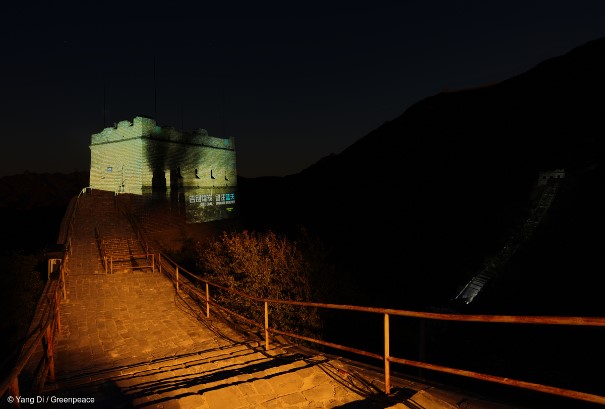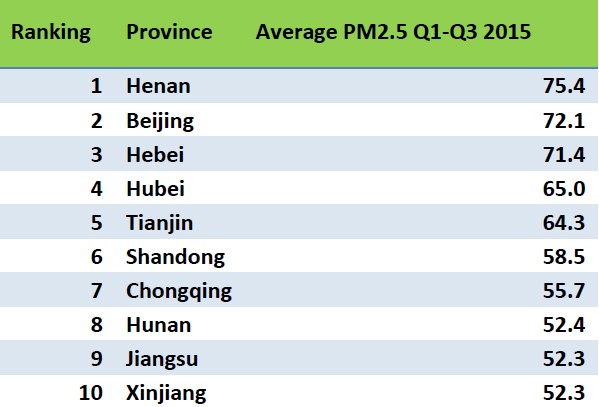
That’s why GPEA activists headed to China’s Great Wall to call on the government to take a stand for blue skies and introduce a coal consumption cap in the upcoming economic plans. Using a projector, they transformed a tower on China’s historic Great Wall into a tableaux of chimneys belching toxic smog into the sky.
Here’s what we discovered from the City Rankings for January- September and why a coal consumption cap is more important than ever:
PM2.5 levels are falling- but not fast enough.
PM2.5 averages are dropping across the country which is great news- but pollution levels are still a major hazard to people’s health. Scientists predicted this year that 3 million people die globally from air pollution. Emissions are gradually reducing and this is a positive trend, but it needs to be scaled up to have a meaningful impact.
The drop in PM2.5 levels coincides with new laws curbing coal pollution
Rankings in July and October showed that the reduction in nationwide air pollution coincided with a 4.1% reduction in industrial coal consumption, largely thanks to new air pollution laws and stricter emission standards. The regional coal caps applied in the past meant that the problem simply moved from east to west. A nationwide coal cap can protect China’s poorer and more vulnerable western areas from bearing the brunt of dangerous, dirty coal pollution.
Temporary measures and ‘Parade Blue’ aren’t cutting it.
Last month, Beijing enjoyed almost two weeks of blue skies and clean air: the result of strict controls on car and industrial emissions ahead of one of the city’s famous military parades. However, despite record breaking low levels of PM2.5, Beijing and the surrounding areas of Tianjin and Hebei still ranked in the top 5 most polluted provinces in the country. These temporary solutions are having a negligible impact on the long term quality of our cities’ air.
China’s 13th Five Year Plan- a blueprint for bluer skies
An initial draft of China’s 13th Five Year Plan- blueprints for short term economic development- is expected to be published early next year. China already missed a big opportunity to take control of its coal consumption last month, when it failed to include a cap in its revision of air pollution laws. It’s crucial that a coal consumption cap is introduced soon, in order to protect Chinese cities in the upcoming years.
There has never been a better time for China to make the leap further away from coal. China has been dubbed the new renewables superpower and not hard to see why: the country invested nearly USD 90 billion in renewables last year and is home to some of the largest solar projects in the world. In the first quarter of 2015, it built more solar than exists in the whole of France and has built up the world’s biggest wind power industry- all in less than a decade.
Capping China’s coal consumption on a national scale is a key step in securing healthy breathable air for the Chinese public- no matter where they live- and turning blue skies from an occasional treat to an everyday reality.
It’s time to step into the future and make a move to quit coal.
Dong Liansai is a climate and energy campaigner for Greenpeace East Asia

